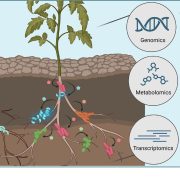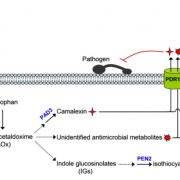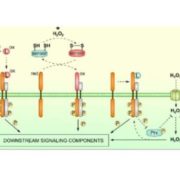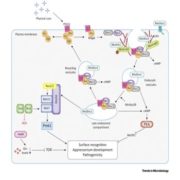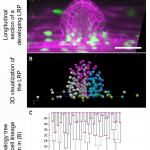An oomycete peptide cytolysin forms transient small pores in lipid membranes (Sci. Adv.)
 NLPs (Necrosis and ethylene-inducing peptide 1–like proteins) are small peptides produced by a variety of plant pathogens. Some NLPs are cytolysins meaning that they trigger lysis of their target cells. Here, Pirc et al. use an assortment of tools including molecular dynamics (MD) simulations, neutron reflectometry (NR), and giant unilamellar vesicles (GUVs) to identify how one of these, NLPPya from the phytopathogenic oomycete Pythium aphanidermatum, interacts with and damages plant cell membranes. Previous studies found that NLPs (shown in purple in the image) preferentially interact with the polar headgroup of glycosylinositol phosphorylceramides (GIPCs; shown in green in the image) at the surface of the plasma membrane through electrostatic interactions, and this interaction is strengthened by the presence of sterols (tan in the image). NLPPya interacts with multiple GIPCs, leading to the formation of aggregates and the opening of small, transient pores in the lipid bilayer. Interestingly this mode of action, in which the NLP sits at the surface of the membane, is different from that of other pore-forming toxins such as those produced by Bacillus thuringiensis (Bt toxin)or Bacillus anthracis (anthrax) which directly insert into the lipid bilayer to produce a pore. These findings will be helpful in developing strategies to combat NLP-producing pathogens. (Summary by Mary Williams @PlantTeaching) Sci. Adv. 10.1126/sciadv.abj9406
NLPs (Necrosis and ethylene-inducing peptide 1–like proteins) are small peptides produced by a variety of plant pathogens. Some NLPs are cytolysins meaning that they trigger lysis of their target cells. Here, Pirc et al. use an assortment of tools including molecular dynamics (MD) simulations, neutron reflectometry (NR), and giant unilamellar vesicles (GUVs) to identify how one of these, NLPPya from the phytopathogenic oomycete Pythium aphanidermatum, interacts with and damages plant cell membranes. Previous studies found that NLPs (shown in purple in the image) preferentially interact with the polar headgroup of glycosylinositol phosphorylceramides (GIPCs; shown in green in the image) at the surface of the plasma membrane through electrostatic interactions, and this interaction is strengthened by the presence of sterols (tan in the image). NLPPya interacts with multiple GIPCs, leading to the formation of aggregates and the opening of small, transient pores in the lipid bilayer. Interestingly this mode of action, in which the NLP sits at the surface of the membane, is different from that of other pore-forming toxins such as those produced by Bacillus thuringiensis (Bt toxin)or Bacillus anthracis (anthrax) which directly insert into the lipid bilayer to produce a pore. These findings will be helpful in developing strategies to combat NLP-producing pathogens. (Summary by Mary Williams @PlantTeaching) Sci. Adv. 10.1126/sciadv.abj9406


